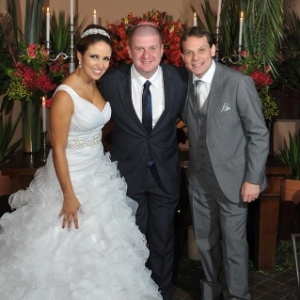No respeitado time de compositores dos sambas-enredos das 14 escolas
do Grupo Especial de São Paulo, dois nomes passam longe do estereótipo
do artista nascido em berço do samba. Amigos de longa data, os judeus
Ronny Potolski e Jairo Roizen emplacaram suas composições na Unidos do
Peruche e na Pérola Negra, driblando qualquer preconceito.
Sem
instrumentos musicais associados ao nome de batismo, como Oswaldinho da
Cuíca, Jackson do Pandeiro e Royce do Cavaco; sem referências a orixás,
santos e divindades, como Xangô da Mangueira, Waldomiro do Candomblé e
Paulinho de Ogum; e sem combinações que adicionam 'ginga' à alcunha dos
sambistas, como Neguinho da Beija-Flor, Nenê da Vila e João Batucada; a
dupla viu a galeria de bambas se abrir para seus dois sobrenomes
incomuns neste universo, e genuinamente judeus.
Potolski e
Roizen estreiam no Anhembi com criações desvinculadas da cultura
judaica. As escolas que eles representam tratam em 2016 de temas do
Brasil – país onde ambos nasceram e foram criados. Na Unidos do Peruche,
o enredo reverencia os 100 anos do samba. Criada juntamente com Marcelo
Madureira, Alex Barbosa, Sukatinha, Bagé, Tubino, Igor Vianna, Thiago
Sousa, Gilson, Kaballa, Victor e Meiners, a composição tem sido apontada
por especialistas como uma das três melhores do ano.
Na Pérola
Negra, com outros parceiros, Jairo Roizen emplacou o samba-enredo que
fala sobre a dança. A composição faz um passeio pela história desta arte
e por sua influência no país, e foi feita ao lado de Celsinho Mody,
Guga Mercadante, Nando do Cavaco, Marcelo Zola, Sidney Arruda, Filosofia
Diley e Xandinho Nocera.
Da sinagoga para a avenida
Jairo Roizen (ao centro) na cerimônia judaica do casamento de Ronny Potolski e Thais Paraguassu
Ronny e Jairo têm muita coisa em comum, a começar pela história das
famílias Potolski e Roizen. Ambas têm raízes na Polônia, Romênia e
Lituânia, e vieram ao Brasil entre a Primeira e a Segunda Guerra Mundial
em busca de oportunidades longe das zonas de conflito da Europa. Mesmo
sem se conhecer, Ronny e Jairo trilharam caminhos quase idênticos em São
Paulo.
Estudaram nos colégios judaicos Renascença e I. L.
Peretz, curtiram o clube A Hebraica, frequentaram a Congregação
Israelita Paulista (CIP) e outras sinagogas, e ouviram os conselhos do
rabino Henry Sobel. Mas só foram se conhecer por meio de uma paixão
brasileira: o samba. Eles foram unidos pelos bastidores das escolas de
samba e por aquele certo glamour do Carnaval que nem todo mundo consegue
entender – nem aceitar.
Os dois meninos judeus foram
apresentados à maior festa popular brasileira ainda crianças. Jairo se
lembra de ter visto o primeiro desfile pela televisão, em 1989, quando
tinha 7 anos. Hoje, com 33, é capaz de reproduzir com detalhes a noite
em que ficou com a avó grudado ao televisor para ver as escolas, que
ainda desfilavam na Avenida Tiradentes. Ronny, 34 anos, também era
vidrado nos desfiles do Rio exibidos pela TV. Sua primeira lembrança é
de acompanhar uma transmissão aos 4 anos de idade. Com 12, quis viver
aquilo mais de perto e passou a colecionar os discos dos sambas-enredo
de Rio e São Paulo.
"A gente não celebra o Natal, mas em dezembro há uma festa judaica
que também é marcada pela troca de presentes, a Chanuká (Festa das
Luzes). Eu sempre pedia o CD dos sambas-enredo", recorda-se Ronny. Dali
até virar um estudioso do Carnaval foi um passo, conhecendo de perto as
escolas de samba de Santos, frequentando a X-9 Paulistana, na Zona Norte
de São Paulo, e indo a desfiles no Anhembi e na Sapucaí.
Para
Ronny, os três melhores sambas-enredo da história do Carnaval paulista
são o da Rosas de Ouro de 1992 ("Non Duco, Duco - Qual a Minha Cara?"), o
da Gaviões da Fiel de 1995 ("O que É Bom É Para Sempre") e o da X-9
Paulistana de 1997 ("Amazônia, a Dama do Universo"). No Rio, seu coração
ainda pulsa quando ouve o enredo da Vila Isabel de 1988 ("Kizomba - A
Festa da Raça"), da Mocidade Independente de 1992 ("Sonhar Não Custa
Nada, ou Quase Nada") e o do Salgueiro de 1993 ("Peguei um Ita no
Norte/Explode Coração").
Formado em Ciências da Computação, com
duas pós-graduações em tecnologias ambientais e engenharia de software,
Ronny ganha a vida como consultor de sustentabilidade. Mas dedica boa
parte de seu tempo a um trabalho não remunerado, de diretor-executivo do
site da Sociedade Amantes do Samba Paulista (www.sasp.com.br) criado há
15 anos com o propósito de manter acesa a chama do samba no estado, um
dia injustamente chamado de Túmulo do Samba.
"Com o site, passei
a viver o Carnaval intensamente", diz Ronny, que também se casou com a
porta-bandeira Thais Paraguassu, hoje na Unidos do Peruche. Começaram a
namorar em 2008, quando ela ainda desfilava pela Tucuruvi, e subiram ao
altar em abril de 2015. A noiva se converteu ao judaísmo e reforçou a
ainda tímida ala dos judeus no samba paulistano.
A enredo da
vida de Jairo não é muito diferente. Depois de amargar a decepção de ver
os desfiles do Grupo Especial de 89 só pela TV, ganhou do pai, como
prêmio de consolação, a oportunidade de ir à avenida Tiradentes no dia
seguinte para conferir ao vivo o desfile do Grupo de Acesso. Naquele
ano, o pequeno corintiano viu brilhar a Gaviões da Fiel. "Ali meu pai
arrumou um problema...Teve que me levar para ver o desfile todos os
anos", lembra Jairo.
Já cursando a faculdade de comunicação da
PUC, passou a frequentar a quadra da Rosas de Ouro, por onde desfilou
durante cinco anos. Formado jornalista, hoje atua como assessor de
Imprensa da Liga das Escolas de Samba de São Paulo e também da Federação
Israelita do Estado de São Paulo, além de apresentar o programa semanal
Shalom Brasil, pelo canal comunitário TV Aberta.
Como o amigo,
também passou a colecionar os CDs de sambas-enredo. Diz que ouve pelo
menos um samba por dia, mas jamais pensou em ser compositor. Sua
experiência mais próxima havia sido na escola, no I. L. Peretz. Em 1995,
quando a Gaviões ganhou o Carnaval de São Paulo com o memorável "Me dê a
mão, me abraça, viaja comigo pró céu...", Jairo resolveu se apoderar da
canção para fazer bonito em um desfile da escola. Para comemorar o
Purim (a mais alegre festa da cultura judaica, que inclui o uso de
fantasias), a classe de Jairo criou até um carro alegórico, que desfilou
pelo colégio com uma música feita propositadamente sobre a base do
samba da Gaviões.
A mão dupla do preconceito
Ronny Potolski e a mulher, a porta-bandeira Thais Paraguassu, da Unidos do Peruche
Em 2009, Jairo passou a fazer parte da diretoria da Pérola Negra.
Como diretor de Carnaval da escola, sugeriu, em 2011, o enredo "Abraão, o
Patriarca da Fé", abrindo caminho para derrubar o preconceito de quem
condenava a presença de judeus no samba. Naquele desfile, 300 dos 3.000
componentes da Pérola eram judeus arregimentados na comunidade judaica
de São Paulo. "Pensei naquele enredo como uma homenagem aos meus avós,
que se orgulhavam de me ver no mundo do samba, apesar da origem deles
não ter nada a ver com isso. Foi também uma forma de retribuir aos
brasileiros o carinho com que receberam todos os judeus fugidos da
guerra", diz Jairo.
Antes, em 2003, a Mangueira já tinha levado
Moisés para a avenida com o enredo "Os Dez Mandamentos: o Samba da Paz
Canta a Saga da Liberdade". Mas a este enredo da Pérola, ele credita um
marco na luta contra o preconceito que, em sua opinião, trafega numa via
de mão dupla no país. O problema é que a tolerância das fantasias que
se exprimem na passarela não reflete a realidade do mundo real. Tanto
assim que, apesar dos esforços, judeus mais ortodoxos veem o Carnaval
como uma festa que fere princípios culturais e religiosos do judaísmo. E
sambistas mais conservadores ainda se valem de alguns estereótipos para
acreditar que um sujeito loiro, branco, de olhos azuis e influência da
cultura hebraica não possa fazer samba, viver de samba.
"Ganhar
o concurso de samba-enredo em duas escolas do Grupo Especial de São
Paulo é uma resposta a tudo isso", acredita Jairo. Ronny concorda e
protesta: "Não ter raiz do samba no sangue sempre pesou como um estigma
sobre a gente".
Nessa cruzada contra o preconceito, ambos
defendem o direito de se expressar como cidadãos brasileiros apaixonados
pela arte do samba e sua expressão mais popular, que é o Carnaval. Ser
judeu é um detalhe que, evidentemente, não deveria ter o menor
significado, como não tem o fato de a passista ser católica, o
mestre-sala ser umbandista, o mestre de bateria ser devoto de Ogum – e
de São Jorge ser considerado protetor dos batuqueiros.
Uma boa
demonstração de que é possível conviver com a tolerância religiosa é o
desafio que este ano caiu nas mãos de Ronny. Como Carnavalesco da escola
X-9 de Santos, ele tem a missão de levar para a avenida um desfile
sobre a importância de Nossa Senhora de Monte Serrat para a história da
cidade, da qual é padroeira. Caberá, pois, a um judeu a nobreza de se
despir dos preconceitos para encenar na avenida os tantos milagres que
são atribuídos à santa da Igreja católica, mostrando em suas criações a
diversidade presente na essência do Carnaval.
(
UOL)
Também disponível no Street Striker


























